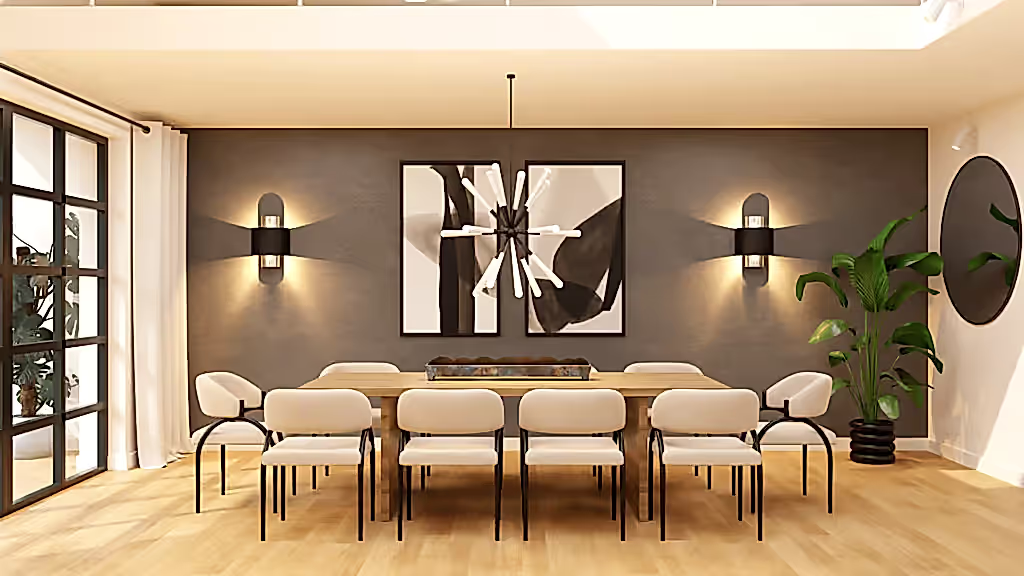Accent walls are a fantastic way to add a touch of personality and style to any room. By focusing on a single wall, you can create a focal point that draws attention and enhances the overall aesthetic of your interior space. Whether you’re looking to introduce a pop of colour, add texture, or highlight a specific area, accent walls offer a versatile and stylish solution. In this article, we’ll explore various ways to use accent walls to enhance your space, along with tips for choosing the right colours, materials, and techniques.
What is an Accent Wall?
An accent wall is a wall that differs in colour, material, or design from the other walls in a room. It’s meant to stand out and draw attention, creating a focal point within the space. Accent walls can be painted, wallpapered, or adorned with various materials such as wood, stone, or tile. The key is to create contrast without overwhelming the room’s overall design.
Benefits of Using Accent Walls

Image credit: House Designer®
Adds Visual Interest:
Accent walls break up the monotony of uniform walls, adding visual interest and making a space feel more engaging and lively.
Defines Spaces:

Image credit: House Designer®
In open-plan living areas, accent walls can help define different zones without the need for physical partitions. For instance, an accent wall can delineate the dining area from the living room, creating a sense of structure within the open space.
Highlights Architectural Features:
Accent walls are an excellent way to highlight architectural features such as fireplaces, built-in shelving, or large windows. By drawing attention to these elements, you can enhance their visual impact.
Choosing the Right Colour
Consider the Room’s Purpose:
When selecting a colour for your accent wall, consider the room’s purpose. For a bedroom, you might choose soothing, calming colours like soft blues or greens. In contrast, a living room might benefit from bolder, more vibrant hues like deep red or navy blue.
Coordinate with Existing Decor:
Ensure that the accent wall colour complements the existing decor and colour scheme of the room. You can use a colour wheel to find complementary colours that will enhance the overall look of your space.
Test Paint Samples:
Before committing to a colour, test a few paint samples on the wall. Observe how the colours look at different times of the day and under various lighting conditions. This will help you make a more informed decision.
Materials and Textures
Paint
Paint is the most common and straightforward way to create an accent wall. It’s versatile and allows for a wide range of colours and finishes. You can also experiment with different painting techniques such as sponging, rag rolling, or stenciling to add texture.
Wallpaper

Image credit: House Designer®
Wallpaper offers endless design possibilities, from bold patterns to subtle textures. It’s an excellent option for creating a dramatic accent wall without the need for additional decor. Removable wallpaper is also available, making it easier to change the look if desired.
Wood Panels
Wood panels add warmth and texture to a room. They can be installed in various patterns, such as shiplap, beadboard, or reclaimed wood, to create a rustic or contemporary look. Painted wood panels can also add a unique twist to traditional wood accent walls.
Stone or Brick:
Stone or brick accent walls add a natural, earthy element to a room. They work well in spaces that aim for a cosy, rustic, or industrial vibe. Faux stone and brick panels are available for easier installation and maintenance.
Placement of Accent Walls

image credit: The contemporist
Behind a Bed:
In bedrooms, placing an accent wall behind the bed creates a stunning focal point. It anchors the bed within the room and adds depth and visual interest to the space. One way to enhance this feature is by incorporating wall panel ideas that bring texture, warmth, and personality to your bedroom design.
Around a Fireplace:
A fireplace naturally draws attention, and an accent wall can enhance its visual impact. Use contrasting colours or materials to make the fireplace stand out even more.

Image credit: House Designer®
In a Dining Area:
Define your dining space with an accent wall. This works particularly well in open-plan areas, where an accent wall can create a distinct dining zone.
In Entryways or Hallways:
Entryways and hallways are often overlooked spaces. An accent wall in these areas can make a strong first impression and set the tone for the rest of your home.
Tips for Creating the Perfect Accent Wall

Benjamin Moore
Keep it Balanced:
While accent walls are meant to stand out, they should still harmonise with the rest of the room. Avoid using colours or patterns that clash with your existing decor.
Use Decor to Enhance the Wall:
Complement your accent wall with decor that enhances its effect. For example, use artwork, mirrors, or shelves to add dimension and interest.
Avoid Overuse:
Too many accent walls can make a space feel disjointed. Stick to one accent wall per room to maintain a cohesive look.
Transform your space with Accent Walls

Image credit: House Designer®
Accent walls are a versatile and effective way to enhance your interior design. By carefully selecting colours, materials, and placement, you can create stunning focal points that add depth, interest, and character to any room. Whether you opt for a bold paint colour, textured wallpaper, or natural materials like wood or stone, an accent wall can transform your space and reflect your personal style. So, go ahead and experiment with accent walls to elevate your home’s interior design.






